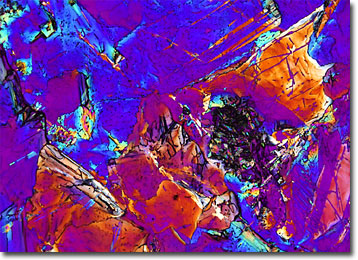Polarized Light Microscopy Digital Image Gallery
Glutaric Acid
A 5-carbon aliphatic dicarboxylic acid, glutaric acid is produced in the body as an intermediate in lysine, fatty acid, and tryptophan metabolism. In humans, however, elevated levels of the organic acid can be extremely dangerous and is symptomatic of a relatively rare disorder called glutaric aciduria.

Glutaric acid, which is isomeric with pyrotartaric acid, has the lowest melting point of all dicarboxylic acids and is highly soluble in water. Also, the structure of the substance helps facilitate the creation of polymer resins that are more elastic than those formed with many other materials. Due to these and other beneficial characteristics, glutaric acid is utilized as a resin intermediate and for a variety of other applications. The substance is, for instance, often a component in cleaning products and detergents, plasticizers, and pharmaceuticals.
Several different types of glutaric aciduria have been identified and all can be very serious. Type I, for instance, is a recessive genetic disorder caused by a defect in the enzyme peroxisomal glutaryl-CoA dehydrogenase, which is involved in the metabolism of the amino acids lysine and tryptophan. The defective enzyme hinders the proper digestion of protein, resulting in a build-up of glutaric acid in the bloodstream. Often misdiagnosed as cerebral palsy, infants suffering from the condition typically suffer damage to nerve clusters in the brain, leading to permanent mental and physical disabilities.
